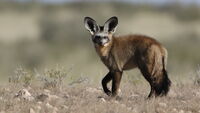Bat-eared fox
| Bat-eared fox | |
|---|---|

| |
| Scientific classification | |
| Kingdom Information | |
| Domain | Eukaryota |
| Kingdom | Animalia |
| Subkingdom | Bilateria |
| Branch | Deuterostomia |
| Phylum Information | |
| Phylum | Chordata |
| Sub-phylum | Vertebrata |
| Infraphylum | Gnathostomata |
| Class Information | |
| Superclass | Tetrapoda |
| Class | Mammalia |
| Sub-class | Theriiformes |
| Infra-class | Holotheria |
| Order Information | |
| Superorder | Preptotheria |
| Order | Carnivora |
| Sub-order | Caniformia |
| Infraorder | Cynoidea |
| Family Information | |
| Family | Canidae |
| Sub-family | Caninae |
| Tribe Information | |
| Tribe | Vulpini |
| Genus Information | |
| Genus | Otocyon |
| Species Information | |
| Species | O. megalotis |
| Population statistics | |
| Population | Unknown (2014 est.)[1] |
| Conservation status | Least concern[2] |
The bat-eared fox (Otocyon megalotis), also known as the big-eared, black-eared, or cape fox, is a wild fox of the family Canidae, and found throughout much of eastern and southern Africa.
Description
The bat-eared fox is small, with a body length of 18 to 26 inches, a standing height at the shoulder of 12 to 16 inches, and a body weight of 7 to 12 pounds. They are a buff-brown in color, lightly-grizzled with gray. The legs, snout, and back stripe to the tip of the tail is a blackish-gray, as well as a "mask" surrounding the eyes to the mouth lining. The ears are very large with a white interior. Cubs are grayer in color, with smaller ears.
The animal was possibly named in reference to a species of bat (Nycteris thebaica), which also has very large ears and is common within that part of Africa.
Subspecies
- Otocyon megalotis canescens; southern Africa
- Otocyon megalotis megalotis; eastern Africa
Range and habitat
Bat-eared foxes live primarily in short-grass plains; they are also found within large areas characterized by scrub vegetation, bare ground, arid and semi-arid deserts and savannas[3]. The northern subspecies is also found in open, taller-grassland of the Serengeti. Both subspecies have been known to have a range overlapping one of their primary food sources, the termites of genera Hodotermes and Microhodotermes.
Diet
Termites form a large amount of their diet, so much so that they are considered an effective means of termite control[4]. in addition, they also prey upon other insects, small vertebrates, such as rodents, lizards, and frogs, birds eggs, and occasionally plants.
Threats
The ICUN classifies the bat-eared fox as "least concern", due to the species' extensive range and large population. However, it is still prosecuted to some extent; farmers consider it to be a threat to small livestock[5], and occasionally they are killed for the skins. Rabies is also a threat, as the disease will cause an immediate, localized population drop[6][7].
References
- ↑ https://www.iucnredlist.org/species/15642/46123809#population
- ↑ https://www.iucnredlist.org/species/15642/46123809
- ↑ https://www.researchgate.net/publication/250932601_Field_Observations_on_the_Behaviour_and_Social_System_of_the_Bat-eared_Fox_Otocyon_megalotis_Desmarest1
- ↑ https://www.canids.org/canidnews/6/Bat-eared_fox_diet_in_South_Africa.pdf
- ↑ http://files.webb.uu.se/uploader/858/MFS-113kurberg-linda.pdf
- ↑ https://pubmed.ncbi.nlm.nih.gov/7777325/
- ↑ https://pubmed.ncbi.nlm.nih.gov/7777327/